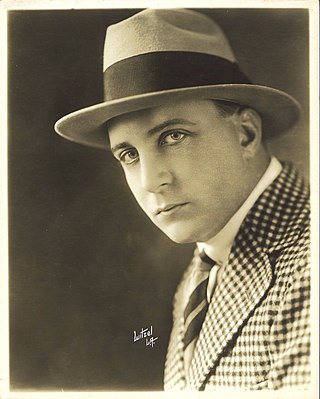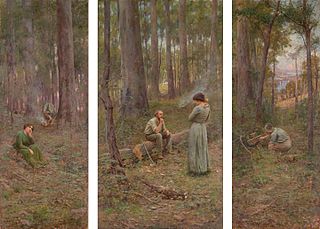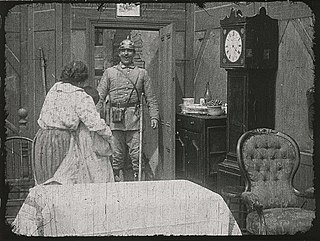Related Research Articles

Smithy is a 1946 Australian adventure film about pioneering Australian aviator Sir Charles Kingsford Smith directed by Ken G. Hall starring Ron Randell. It was Hall's last feature film as a director.

William Joseph Lincoln was an Australian playwright, theatre manager, film director and screenwriter in the silent era. He produced, directed and/or wrote 23 films between 1911 and 1916.

John F. Gavin was a pioneer Australian film actor and director, one of the early filmmakers of the 1910s. He is best known for making films about bushrangers such as Captain Thunderbolt, Captain Moonlite, Ben Hall and Frank Gardiner. Known informally as 'Jack', Gavin worked in collaboration with his wife Agnes, who scripted many of his films.

Arthur Greville Collins was a British-born film director.

Arthur Shirley was an Australian actor, writer, producer, and director of theatre and film. He experienced some success as a film actor in Hollywood between 1914 and 1920.

Alfred Rolfe, real name Alfred Roker, was an Australian stage and film director and actor, best known for being the son-in-law of the celebrated actor-manager Alfred Dampier, with whom he appeared frequently on stage, and for his prolific output as a director during Australia's silent era, including Captain Midnight, the Bush King (1911), Captain Starlight, or Gentleman of the Road (1911) and The Hero of the Dardanelles (1915). Only one of his films as director survives today.
Nurse Cavell is a 1916 Australian feature-length film directed by W. J. Lincoln about the execution of Edith Cavell during World War I. It was also known as Edith Cavell.
La Revanche, also known as The Vengeance, is a 1916 Australian feature-length film directed by W. J. Lincoln about the revenge sought by Belgian friends of Edith Cavell against the Germans during World War I. It was a sequel to Nurse Cavell (1916), using many of the same cast and crew.

The Life's Romance of Adam Lindsay Gordon is a 1916 Australian feature-length film directed by W. J. Lincoln, based on the life of poet Adam Lindsay Gordon.
Charles Cozens Spencer was a British-born film exhibitor and producer, who was a significant figure in the early years of the Australian film industry. He produced films under the name Spencer's Pictures and was an early backer of the films of Raymond Longford. He was also instrumental in the creation of "The Combine".

Captain Midnight, the Bush King is a 1911 Australian silent Western film about the fictitious bushranger Captain Midnight. It was the directorial debut of actor Alfred Rolfe. The film is based on the play of same name by W. J. Lincoln and Alfred Dampier. Captain Midnight, the Bush King is now considered lost.
The Life of Rufus Dawes is a 1911 Australian silent film based on Alfred Dampier's stage adaptation of the 1874 novel For the Term of His Natural Life produced by Charles Cozens Spencer.
Cupid Camouflaged is a 1918 Australian silent film directed by Alfred Rolfe. It is a high society melodrama. The film was made to aid fund raising for the Red Cross. It is considered a lost film.

The Pioneers is a 1916 Australian silent film directed by Franklyn Barrett. It is considered a lost film.

The Joan of Arc of Loos is a 1916 Australian silent film shot by Franklyn Barrett based on the true story of Émilienne Moreau-Evrard in World War I. Only a portion of the movie survives today.
For Australia is a 1915 Australian silent film directed by Monte Luke.
Amalgamated Pictures Ltd was a film exchange company in Australia.
Australasian Films, full name Union Theatres and Australasian Films, was an Australian film distribution and production company formed in 1913 that was wound up in the 1930s to merge into Greater Union. The Union Theatres and Australasian Films dominated cinema in Australia in the 1910s and 1920s.
The Austral Photoplay Company was a short lived Australian production and distribution company. It was established in Melbourne in 1913 by A. C. Tinsdale and later transferred to Sydney in 1917. It initially sought to raise £10,000 to make a film about the goldfields.
A Man – That's All (1916) is an Australian war film directed by Alfred Rolfe for Australasian Films.
References
- ↑ "Classified Advertising". The Argus . Melbourne: National Library of Australia. 13 May 1918. p. 12. Retrieved 19 July 2012.
- 1 2 Marsden, Ralph. 'The Old Tin Shed in Exhibition Street': The J. C. Williamson Studio, Melbourne's Forgotten Film Factory [online]. Metro Magazine: Media & Education Magazine, No. 157, 2008: 144-153. Availability: <http://search.informit.com.au/documentSummary;dn=519108300276483;res=IELAPA> ISSN 0312-2654. [cited 15 Nov 14].
- 1 2 Andrew Pike and Ross Cooper, Australian Film 1900–1977: A Guide to Feature Film Production, Melbourne: Oxford University Press, 1980, p104
- ↑ "Classified Advertising". The Argus . Melbourne: National Library of Australia. 23 May 1918. p. 12. Retrieved 19 July 2012.
- ↑ "A WOMAN'S MELBOURNE LETTER". Western Mail . Perth: National Library of Australia. 17 May 1918. p. 27. Retrieved 19 July 2012.
- ↑ "FROM NEAR AND FAR". The Sydney Morning Herald . National Library of Australia. 22 May 1918. p. 7. Retrieved 19 July 2012.
- ↑ "Advertising". South Bourke and Mornington Journal . Richmond, Vic.: National Library of Australia. 18 July 1918. p. 2 Edition: WEEKLY. Retrieved 19 July 2012.
- ↑ "RED CROSS APPEAL". The Argus . Melbourne: National Library of Australia. 22 May 1918. p. 8. Retrieved 19 July 2012.
- ↑ "MELBOURNE NOTES". The Sydney Morning Herald . National Library of Australia. 29 May 1918. p. 7. Retrieved 19 July 2012.
- ↑ "Australian Notes", Moving Picture World 6 Jul 1918 – 31 Aug 1918 p. 1128